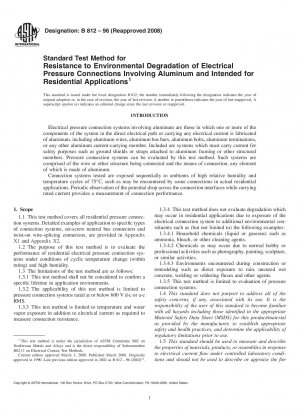ASTM B812-96(2008)
Standard Test Method for Resistance to Environmental Degradation of Electrical Pressure Connections Involving Aluminum and Intended for Residential Applications
- Standard No.
- ASTM B812-96(2008)
- Release Date
- 1996
- Published By
- American Society for Testing and Materials (ASTM)
- Status
- Replace By
- ASTM B812-96(2013)
- Latest
- ASTM B812-18
- Scope
The principal underlying the test is the sensitivity of the electrical contact interface to temperature and humidity cycling that electrical pressure connection systems experience as a result of usage and installation environment. The temperature cycling may cause micromotion at the mating electrical contact surfaces which can expose fresh metal to the local ambient atmosphere. The humidity exposure is known to facilitate corrosion on freshly exposed metal surfaces. Thus, for those connection systems that do not maintain stable metal-to-metal contact surfaces under the condition of thermal cycling and humidity exposure, repeated sequences of these exposures lead to degradation of the contacting surface indicated by potential drop increase.
The test is of short duration relative to the expected life of connections in residential usage. Stability of connection resistance implies resistance to deterioration due to environmental conditions encountered in residential service. Increasing connection resistance as a result of the test exposure indicates deterioration of electrical contact interfaces. Assurance of long term reliability and safety of connection types that deteriorate requires further evaluation for specific specified environments and applications.
Use8212;It is recommended that this test method be used in one of two ways. First, it may be used to evaluate and report the performance of a particular connection system. For such use, it is appropriate to report the results in a summary (or tabular) format such as shown in Section 18, together with the statement “The results shown in the summary (or table) were obtained for (insert description of connection) when tested in accordance with Test Method B 812. Second, it may be used as the basis for specification of acceptability of product. For this use, the minimum test time and the maximum allowable increase in potential drop must be established by the specifier. Specification of connection systems in accordance with this use of the standard test method would be of the form: “The maximum potential drop increase for any connection, when tested in accordance with Test Method B 812 for a period of weeks, shall be mV relative to the reference connections.” Connection systems that are most resistant to thermal-cycle/humidity deterioration, within the limitations of determination by this test method, show no increase in potential drop, relative to the reference connections, when tested for indefinite time. Connections that are less resistant to thermal-cycle/humidity conditions applied by this test will demonstrate progressive increases in potential drop with increasing time on test. Thus, the following examples of specifications are in the order of most stringent (No. 1) to least stringent (No. 3).
Duration, weeks Maximum Potential Drop Increase, mV 1. 52 0 2. 16 0.2 3. 4 1.0 1.1 This test method covers all residential pressure connection systems. Detailed examples of application to specific types of connection systems, set-screw neutral bus connectors and twist-on wire-......
ASTM B812-96(2008) Referenced Document
- ANSI/NFPA 70 National Electrical Coder*, 2013-01-01 Update
- ASTM B542 Standard Terminology Relating to Electrical Contacts and Their Use*, 2019-11-01 Update
ASTM B812-96(2008) history
- 2018 ASTM B812-18 Standard Test Method for Resistance to Environmental Degradation of Electrical Pressure Connections Involving Aluminum and Intended for Residential Applications
- 1996 ASTM B812-96(2013) Standard Test Method for Resistance to Environmental Degradation of Electrical Pressure Connections Involving Aluminum and Intended for Residential Applications
- 1996 ASTM B812-96(2008) Standard Test Method for Resistance to Environmental Degradation of Electrical Pressure Connections Involving Aluminum and Intended for Residential Applications
- 1996 ASTM B812-96(2002)e1 Standard Test Method for Resistance to Environmental Degradation of Electrical Pressure Connections Involving Aluminum and Intended for Residential Applications
- 1996 ASTM B812-96 Standard Test Method for Resistance to Environmental Degradation of Electrical Pressure Connections Involving Aluminum and Intended for Residential Applications
